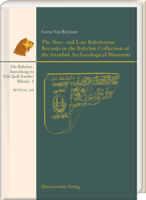|
|
more titles of the subject:
Download:
Please note: With adding digital Products to your cart
the payment will be handled via PayPal. The download will be provided after the payment is confirmed. With this publication Greta Van Buylaere presents the first comprehensive edition of the Babylonian records from the first millennium BCE, now in the Babylon Collection of the Istanbul Archaeological Museums, which contain a wealth of literary, administrative and historical texts. Many of the tablets have remained unedited and little researched – until now.
The library texts include incantations, Balaĝ compositions and a Seleucid manuscript of the bilingual Balaĝ prayer Ukkin-ta eš-bar til-la. There are student exercises like Syllabary A and the Extended Vocabulary B as well as tablets with short excerpts. The Neo-Babylonian administrative documents include six tablets from the archive of the South Palace of Babylon (N1), on which grain deliveries to the palace of Nebuchadnezzar II are recorded, as well as a tablet found in the Ištar Temple (N8), on which the fate of a group of criminals is documented. The largest group of texts comprises royal inscriptions from the Neo-Assyrian kings Sennacherib, Esarhaddon and Ashurbanipal and the Babylonian kings Nabopolassar, Nebuchadnezzar II, Neriglissar and Nabonidus. An appendix lists ninety stamped or inscribed bricks from Babylon, most of which date back to Nebuchadnezzar II, offering further testimony to the rich historical legacy preserved in this underexplored collection. |
|||||||||||||||||||||||||||||||||||||






